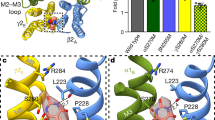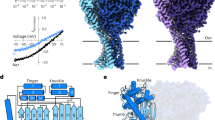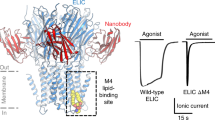Abstract
SEVERAL theories of general anaesthesia account for the depression of neuronal excitability as a depression of membrane mechanisms underlying axonal conduction1–4 or synaptic transmission5–16. The latter is more likely since general anaesthetics depress transmission in concentrations which do not block axonal conduction6,7,11,15,18. In vertebrates, excitatory postsynaptic potentials (epsps) are invariably depressed12,15–20, while under the same conditions inhibitory postsynaptic potentials (ipsps)4,21–23 and excitatory presynaptic potentials (resulting in presynaptic inhibition) are preserved (and prolonged)24–27. Using invertebrate preparations we found28 that (1) pentobarbital selectively and reversibly depresses Na+-dependent epsps without affecting either Cl−- or K+-dependent ipsps, and (2) pentobarbital and other central nervous system (CNS) depressants selectively and reversibly depress postsynaptic excitation (induced by application of putative transmitters) which is coupled primarily to an increase in Na+ conductance without affecting postsynaptic inhibition (induced by application of putative transmitters) which is coupled to either Cl− or K+ conductance increases. Selective depression of postsynaptic excitation would presumably lead to a decrease in the ratio of epsps to ipsps and thus account for much of the generalised decrease in neuronal activity during general anaesthesia. The observations by Meyer29 and Overton30 that general anaesthetic potency is directly proportional to the oil/water partition coefficient have prompted me to investigate the correlation between depressant activity and hydrophobicity. I report here that (1) depressant activity on invertebrate postsynaptic membranes is quantitatively correlated with hydrophobicity (r=0.982), and (2) analysis of published data from a vertebrate preparation indicates that the ratio of drug concentrations depressing axonal conduction and synaptic transmission equally is also quantitatively correlated with hydrophobicity (r = 0.96).
This is a preview of subscription content, access via your institution
Access options
Subscribe to this journal
Receive 51 print issues and online access
$199.00 per year
only $3.90 per issue
Buy this article
- Purchase on Springer Link
- Instant access to full article PDF
Prices may be subject to local taxes which are calculated during checkout
Similar content being viewed by others
References
Thesleff, S., Acta Physiol. Scand., 37, 335 (1956).
Thornton, J. A., Whelpton, D., and Brown, B. H., Br. J. Anaesth., 40, 583 (1963).
Blaustein, M. P., J. gen. Physiol., 49, 1043 (1966).
Seeman, P., Pharm. Rev., 24, 583 (1972).
Brooks, C. McC., and Eccles, J. C., J. Neurophysiol., 10, 349 (1947).
Larrabee, M. G., and Posternak, J. M., J. Neurophysiol., 15, 91 (1952).
Shapovolov, A. I., Farmakol. Toksikol., 26, 150 (1963).
Loyning, Y., Oshima, T., and Yokota, T., J. Neurophysiol., 27, 408 (1964).
Mathews, E. K., and Quilliam, J. P., Br. J. Pharm., 22, 415 (1966).
Paton, W. D. M., and Speden, R. N., Br. Med. Bull., 21, 44 (1965).
Somjen, G. G., Anesthesiology, 28, 135 (1967).
Karis, J. H., Gissen, A. J., and Nastuk, W. L., Anesthesiology, 28, 128 (1967).
Sato, M., Austin, G. M., and Yoi, H., Nature, 215, 1506 (1967).
Chalazonitis, N., Anesthesiology, 28, 111 (1967).
Richards, C. D., J. Physiol., Land., 227, 749 (1972).
Nicoll, R. A., J. Physiol., Lond., 223, 803 (1972).
Richards, C. D., J. Physiol., Lond., 233, 439 (1973).
Somjen, G. G., and Gill, M., J. Pharmac. exp. Ther., 140, 19 (1963).
Westmoreland, B. F., Ward, D., and Johns, T. R., Brain Res., 26, 465 (1971).
Thomson, T. D., and Turkanis, S. A., Br. J. Pharm., 48, 48 (1973).
Weakly, J. N., Esplin, D. W., and Zablocka, B., Arch. int. Pharm. Ther., 171, 385 (1968).
Larson, M. D., and Major, M. A., Brain Res., 21, 309 (1970).
Eccles, J. C., Faber, D. S., and Taborikova, H., Brain Res., 25, 335 (1971).
Eccles, J. C., and Malcolm, J. L., J. Neurophysiol., 9, 139 (1946).
Eccles, J. C., Schmidt, R. F., and Willis, W. D., J. Physiol, Lond., 168, 500 (1963).
Schmidt, R. F., Ergb. Physiol., 63, 21 (1971).
Miyahara, J. T., Esplin, D. W., and Zablocka, B., J. Pharm. exp. Ther., 154, 118 (1966).
Barker, J. L., and Gainer, H., Science, 182, 720 (1973).
Meyer, K. H., Trans. Faraday Soc., 33, 1062 (1937).
Overton, E., Z. phys. Chem., 22, 189 (1896).
Gissen, A. J., Karis, J. H., and Nastuk, W. L., J. Am. med. Assoc., 197, 770 (1966).
Adams, P. R., Cash, H. C., and Quilliam, J. P., Br. J. Pharm., 40, 552–553P (1970).
Lee Son, S., Waud, B. E., and Waud, D. R., Fedn Proc., 33, 510 (1974).
Krnjevic, K., and Phillis, J. W., J. Physiol., Lond., (in the press).
Crawford, J. M., and Curtis, D. R., J. Physiol., Lond., 186, 121 (1966).
Galindo, A., J. Pharm. exp. Ther., 177, 360 (1971).
Crawford, J. M., Neuropharmacology, 9, 31 (1970).
Bradley, P. B., and Dray, A., Br. J. Pharm., 48, 212 (1973).
Narahashi, T., Moore, J. W., and Poston, R. N., J. Neurobiol., 1, 3 (1969).
Larrabee, M. G., Ramos, J. G., and Bulbring, E., J. cell. comp. Physiol., 40, 461 (1952).
Hansch, C., and Dunn, W. J., J. Pharm. Sci., 61, 1 (1972).
Quastel, D. M. J., Hackett, J. T., and Cooke, J. D., Science, 172, 1034 (1971).
Weakly, J. N., J. Physiol., Lond., 204, 63 (1969).
Price, H. L., and Dripps, R. D., in The pharmacological basis of therapeutics (edit. by Goodman, L. S., and Gilman, A.), 83 (Macmillian, New York, 1965).
Adams, P. R., J. Physiol. Lond., (in the press).
Quastel, D. M. J., and Linder, M., Symp. Molecular mechanisms of anesthesia, Seattle, 11 (1974).
Leo, A., Hansch, C., and Elkins, D., Chem. Rev., 71, 525 (1971).
Author information
Authors and Affiliations
Rights and permissions
About this article
Cite this article
BARKER, J. Activity of CNS depressants related to hydrophobicity. Nature 252, 52–54 (1974). https://doi.org/10.1038/252052a0
Received:
Revised:
Issue Date:
DOI: https://doi.org/10.1038/252052a0
This article is cited by
Comments
By submitting a comment you agree to abide by our Terms and Community Guidelines. If you find something abusive or that does not comply with our terms or guidelines please flag it as inappropriate.



